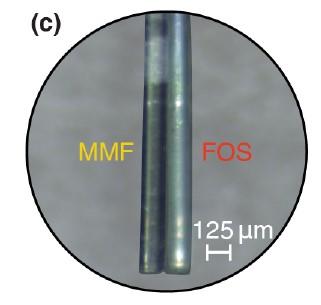New microendoscope poised to advance our understanding of the brain

Credit: Emmanuel Bossy, CNRS/ Université Grenobe Alpes Laboratoire Interdisciplinaire de Physique
WASHINGTON — Researchers have demonstrated a new endoscope that uniquely combines photoacoustic and fluorescent imaging in a device about the thickness of a human hair. The device could one day provide new insights into the brain by enabling blood dynamics to be measured at the same time as neuronal activity.
“Combining these imaging modalities could improve our understanding of the brain’s structure and behavior in specific conditions such as after treatment with a targeted drug,” said research team leader Emmanuel Bossy from the CNRS/ Université Grenobe Alpes Laboratoire Interdisciplinaire de Physique. “The endoscope’s small size helps minimize damage to tissue when inserting it into the brains of small animals for imaging.”
In The Optical Society (OSA) journal Biomedical Optics Express, Bossy’s research team, in collaboration with Paul C. Beard’s team from University College London, describe their new multi-modality endoscope and show that it can acquire photoacoustic and fluorescent images of red blood cells and fluorescent beads.
Two images are better than one
Acquiring fluorescence and photoacoustic images with the same device provides automatically co-registered images with complementary information. Fluorescent signals, which are created when a fluorescent marker absorbs light and re-emits it with a different wavelength, are most useful for labeling specific regions of tissue. On the other hand, photoacoustic images, which capture an acoustic wave generated after the absorption of light, do not require labels and thus can be used to image blood dynamics, for example.
The new endoscope uses a technique called optical wavefront shaping to create a focused spot of light at the imaging tip of a very small multi-mode optical fiber. “Light propagating into a multi-mode fiber is scrambled, making it impossible to see through the fiber,” said Bossy. “However, this type of fiber is advantageous for endoscopy because it is extremely small compared to the bundles of imaging fibers used for many medical endoscopic devices.”
To see through the multi-mode optical fiber, the researchers used the spatial light modulator to send specific light patterns through the fiber and create a focus spot at the imaging end. When the focus spot hits the sample, it creates a signal that can be used to build up an image point by point by raster scanning the spot over the sample. Although other researchers have used multimode fibers for fluorescence endoscopy, the new work represents the first time that photoacoustic imaging has been incorporated into this type of endoscope design.
Adding sound sensitivity
The researchers added photoacoustic imaging by incorporating an additional, very thin optical fiber with a special sensor tip that is sensitive to sound. Because commercially available fiber optic acoustic sensors are not sensitive or small enough for this application, the researchers used a very sensitive fiber optic sensor recently developed by Beard’s research team.
“The focused spot of light allows us to build the image pixel by pixel while also increasing the strength of fluorescence and photoacoustic signals because it concentrates the light at the focal spot,” explained Bossy. “This concentrated light combined with a sensitive detector made it possible to obtain images using only one laser pulse per pixel, whereas commercial fiber optic acoustic sensors would have required many laser pulses.”
The researchers fabricated a prototype microendoscope that measured just 250 by 125 microns squared and used it to image fluorescent beads and blood cells using both imaging modalities. They successfully detected multiple 1-micron fluorescent beads and individual 6-micron red blood cells.
Because fluorescence endoscopy in rodent’s brain has been performed by other scientists, the researchers are confident that their dual modality device will work in similar conditions. They are now continuing work to increase the device’s acquisition speed, with a goal of acquiring a few images per second.
###
Paper: S. Mezil, A. M. Caravaca-Aguirre, E. Z. Zhang, P. Moreau, I. Wang, P. C. Beard, E. Bossy, “Single-shot hybrid photoacoustic-fluorescent microendoscopy through a multimode fiber with wavefront shaping,” Biomed. Opt. Express, volume 11, issue 10, pp. 5717-5727 (2020).
DOI: https:/
About Biomedical Optics Express
Biomedical Optics Express is OSA’s principal outlet for serving the biomedical optics community with rapid, open-access, peer-reviewed papers related to optics, photonics and imaging in biomedicine. The journal scope encompasses fundamental research, technology development, biomedical studies and clinical applications. It is published monthly by The Optical Society and edited by Christoph Hitzenberger, Medical University of Vienna, Austria. Biomedical Optics Express is online at OSA Publishing.
About The Optical Society
Founded in 1916, The Optical Society (OSA) is the leading professional organization for scientists, engineers, students and business leaders who fuel discoveries, shape real-life applications and accelerate achievements in the science of light. Through world-renowned publications, meetings and membership initiatives, OSA provides quality research, inspired interactions and dedicated resources for its extensive global network of optics and photonics experts. For more information, visit osa.org.
Media Contact:
[email protected]
Media Contact
James Merrick
[email protected]
Original Source
https:/
Related Journal Article
http://dx.




